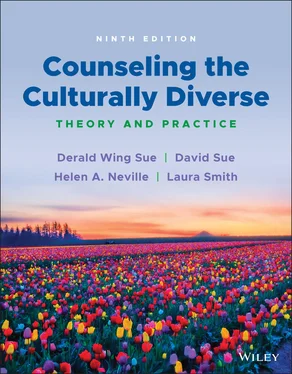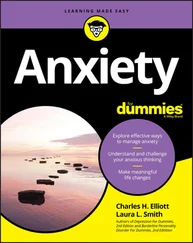The discriminatory experiences of transgender people have been very rarely studied in psychology (Nadal, Rivera, & Corpus, 2010), yet there is evidence to suggest that the pervasive daily discrimination faced by this population is associated with an elevated risk for suicide (Marzullo & Libman, 2009). One term used to define prejudice against transgender individuals is transphobia, “an emotional disgust toward individuals who do not conform to society's gender expectations” (Hill & Willoughby, 2005, p. 533). There is recent evidence to suggest that the microaggressions experienced by transgender individuals are distinct from those experienced by lesbian, gay, and bisexual people (Nadal, Skolnik, & Wong, 2012; Nadal, Griffin, Wong, Davidoff, & Davis, 2017).
What makes the phenomenon of racial, gender and LGBTQ microaggressions particularly complex is that ambiguity and alternative explanations obscure the true meaning of the behavior not only for the person who engages in it, but also for the person on the receiving end.
THE EVOLUTION OF THE “ISMS”: MICROAGGRESSIONS
Microaggressions are “brief and commonplace daily verbal or behavioral indignities, whether intentional or unintentional, that communicate hostile, derogatory, or negative racial slights and insults that potentially have a harmful or unpleasant psychological impact on the target person or group” (Sue, Bucceri, Lin, Nadal, & Torino, 2007). They can also be delivered environmentally, as in the case of Melanie, through the physical surroundings of target groups, where they are made to feel unwelcome, isolated, unsafe, and alienated.
The term “macroaggression” (Huber & Solorzano, 2015; Sue, Calle, Mendez, Alsaidi, & Glaeser, 2021) refers to systemic and institutional forms of discrimination that impact an entire class of individuals. They are said to reside in the policies, programs, practices, and structures of institutions that disadvantage or oppress socially devalued groups, while benefiting others. Some of them are codified into law such as the former travel ban on Muslim‐majority countries, the former Family Separation Policy, and new voter suppression laws. As explained by Sue et al. (2021), racial macroaggressions represent an overarching umbrella that validates, supports, and enforces the manifestation of individual acts of racial microaggressions.
Based on the literature on subtle forms of oppression, one might conclude the following about microaggressions: they (a) tend to be subtle, unintentional, and indirect; (b) often occur in situations where there are alternative explanations; (c) represent unconscious and ingrained biased beliefs and attitudes; and (d) are more likely to occur when people pretend not to notice differences, thereby denying that race, sex, sexual orientation, religion, or ability had anything to do with their actions (Sue, Capodilupo, et al., 2007). Three types of microaggression have been identified: microassault, microinsult, and microinvalidation.
The term “ microassault” refers to a blatant verbal, nonverbal, or environmental attack intended to convey discriminatory and biased sentiments. This notion is related to overt racism, sexism, heterosexism, ableism, and religious discrimination, in which individuals deliberately convey derogatory messages to target groups. Using epithets like “spic,” “faggot,” or “kyke”; requesting not to sit next to a Muslim on an airplane; and deliberately serving disabled patrons last are examples. Unless we are talking about White supremacists, most perpetrators with conscious biases will engage in overt discrimination only under three conditions: (a) when some degree of anonymity can be insured; (b) when they are in the presence of others who share or tolerate their biased beliefs and actions; or (c) when they lose control of their feelings and actions.
Microinsultsare unintentional behaviors or verbal comments that convey rudeness or insensitivity or demean a person's racial heritage/identity, gender identity, religion, ability, or sexual orientation identity. Despite being outside the level of conscious awareness, these subtle snubs are characterized by an insulting hidden message. For example, when a person frantically rushes to help a person with a disability on to public transportation, the underlying message is that disabled people are in constant need of help and dependent on others. When an African American man walks into the elevator occupied by a single White female rider, she becomes fearful. Her entire body tenses up, she moves to the other end of the car, and clutches her purse tightly. In other words, her entire demeanor conveys fear that she will be assaulted or robbed.
Microinvalidationsare verbal comments or behaviors that exclude, negate, or dismiss the psychological thoughts, feelings, or experiential reality of a target group. Like microinsults, they are unintentional and usually outside the perpetrator's awareness. A frequent refrain to the “Black Lives Matter” slogan is that “all lives matter.” These statements negate the sociohistorical and political lived experience of Black people. In other words, the comeback denies the racialized experiences of African Americans, implies that being Black is no different than being white, and by extension suggests all lives are equally valued in our society. Such statements have been coined by researchers as “color‐blind” attitudes, and research shows that among White adults in a workplace setting, higher color‐blind attitudes are associated with lower likelihoods of perceiving microaggressions (Offermann et al., 2014). This last point is extremely important for counselor/therapists who may approach clients of color with a color‐blind attitude.
African Americans experience frequent microaggressions in their daily lives:
32% of Black adults said people behaved as if they were “better than you.”
27% of people acted as if they were afraid of them.
23% of people acted as if Blacks were dishonest.
With the rise in Anti‐Asian sentiment in the United States, the experience of microaggressions by this group has also increased.
3,800 hate crimes were recorded against AAPI groups from March 2020–February 2021. Although hate crimes are not racial microaggressions, they are harbingers of implicit bias.
31% of Asian Americans reported they were objects of racial slurs and jokes.
64% believe the political rhetoric (reference to Covid‐19 as the Wuhan virus, China virus, and Kungflu) unmasked beliefs that AAPI groups are foreigners and blamed.
67% of adults, and 47% of youth were concerned with their safety.
Sources: Asian American Psychological Association (2021); Gallup Poll (2020).
To further illustrate the concepts of microinsults and microinvalidations, Table 4.1 provides some common examples, as well as their accompanying hidden messages and assumptions. Some of these categories are more applicable to certain forms of microaggression (racial, gender, religion, ability, or sexual orientation), but they all seem to share commonalities.
REFLECTION AND DISCUSSION QUESTIONS
1 In looking at Table 4.1, can you identify how you may have committed microaggressions related to race, gender, sexual orientation, religion, or ability?
2 Compile a list of possible microaggressions you may have committed. Explore the potential hidden messages they communicated to their recipients.
3 What do your microaggressions tell you about your unconscious perception of marginalized groups?
4 If microaggressions are mostly outside the level of conscious awareness, what must you do to make them visible? What steps must you take to personally stop microaggressions?
Читать дальше












